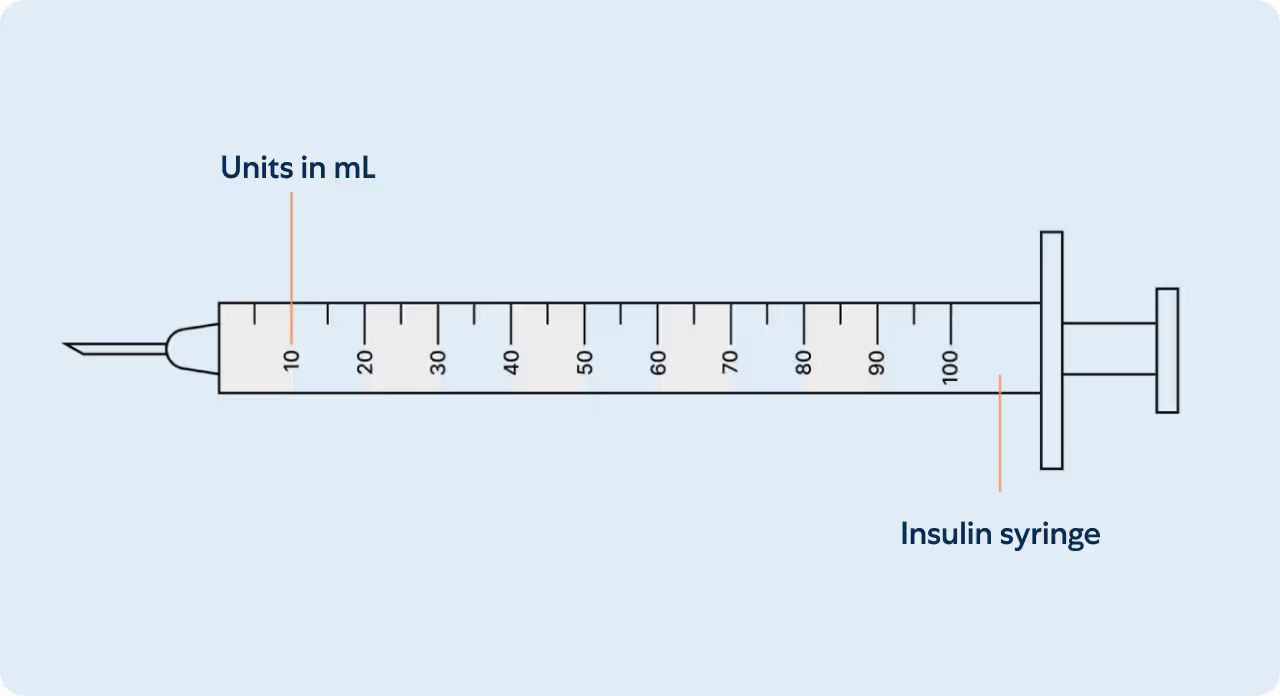Storage
Store at room temperature, away from direct sunlight and moisture. Keep out of reach of children.
Instructions
This information is intended for individuals who have been prescribed Microdosing GLP-1 by their Alan Health provider.
Microdosing GLP-1 is administered as oral drops designed for sublingual absorption.
Step-by-Step Instructions:
- Wash your hands thoroughly.
- Use the syringe to draw the prescribed dose.
- Place the drops under your tongue.
- Hold the liquid under your tongue for at least 60 seconds before swallowing.
- Avoid eating or drinking for 30 minutes post-administration.
Missed Dose? If you miss a dose, skip the missed dose and continue with your regular schedule.
Understanding your insulin syringe

Measuring your dose
Insulin syringes are used for subcutaneous injections. They are marked in Units on the insulin syringe barrel (see illustration). Insulin syringes facilitate the precise measurement of tiny amounts of liquids which are ideal for medications such as insulin that require small and accurate dosing. Unit marks are also expressed in mL’s and can be interchangeably referenced. A prescriber may write a prescription in Units or in mL’s.
Within the amount of liquid is the prescribed mg dosage of your medication (see mg chart). Milligrams (mg) is not an amount of liquid, but rather the amount of drug that is within. The conversion between units and milligrams varies depending on the concentration of the product being used.
What can I expect?
Safety information
The most common side effects of microdosing oral GLP-1 include nausea, abdominal pain, headaches, fatigue, constipation, diarrhea, dizziness, upset stomach, and heartburn. Nausea is particularly common at the start of treatment. Ondansetron (Zofran) may be prescribed to help relieve nausea and should be taken only as needed.
In rare cases, side effects may include pancreatitis, gallbladder disease, kidney injury, or serious allergic reactions. Seek immediate medical attention if you experience any of these symptoms.
A full list of side effects can be found here.
Do not use this product if you are currently pregnant, breastfeeding, or plan to become pregnant or breastfeed without consulting a qualified healthcare provider.
Note: Medications like semaglutide have caused thyroid tumors in laboratory animals. While there is no confirmed link in humans, you should not take this medication if you or a family member has a history of medullary thyroid carcinoma (MTC) or multiple endocrine neoplasia type 2 (MEN-2). Notify your doctor immediately and stop taking the medication if you experience a neck mass/swelling, persistent hoarseness, difficulty swallowing, or neck pain.
You should not take semaglutide if any of the following apply to you:
- History of eating disorders
- Gallbladder disease (does not include gallbladder removal)
- Alcohol or drug abuse
- Recent bariatric surgery
- Pancreatitis
- Personal or family history of medullary thyroid cancer
- MEN-2 syndrome
- Retinopathy
Note: The above statements have not been evaluated by the Food and Drug Administration. This product is not intended to diagnose, treat, cure, or prevent any disease.
Frequently Asked Questions
What is Microdosing GLP-1?
Microdosing GLP-1 is a low-dose protocol using either oral or injectable GLP-1 medication to support long-term health and wellness. By starting with small, gradual doses, this approach aims to promote benefits like improved energy, cognitive function, and metabolic balance—while minimizing potential side effects.
How do you microdose with GLP-1?
Microdosing GLP-1 involves taking small doses—either as oral drops placed under the tongue or as a subcutaneous injection into the fatty layer of skin (such as the abdomen or thigh). Your provider will guide you on the dosing schedule best suited to your wellness goals.
What are the potential benefits of Microdosing GLP-1?
Microdosing GLP-1 is designed to support long-term wellness and healthy aging. By using low, consistent doses, it may help boost energy, improve mood and focus, support cardiovascular and metabolic health, reduce inflammation, and enhance cellular function—all while minimizing the side effects often associated with higher-dose GLP-1 protocols.
This gentle approach is ideal for individuals seeking longevity and wellness benefits.
How long will it take to notice benefits?
Results vary depending on health and lifestyle factors. Most people report feeling more balanced within the first few weeks, with improvements in energy, clarity, and overall wellness. Staying consistent with your schedule is key.
How is microdosing different from standard GLP-1 use?
Microdosing typically uses lower doses than those prescribed for diabetes or weight management, focusing instead on promoting daily wellness and metabolic balance. Dosing strategies can vary based on individual goals.
Is Microdosing GLP-1 for weight loss?
Microdosing GLP-1 is not intended for weight loss. If weight loss is your primary goal, we recommend exploring our weight loss treatments here!
Additional support
For details about your medication and dosing, please log in to your patient portal. Your physician is here to help with any medical questions. If you are experiencing a medical emergency, call 911 right away.













